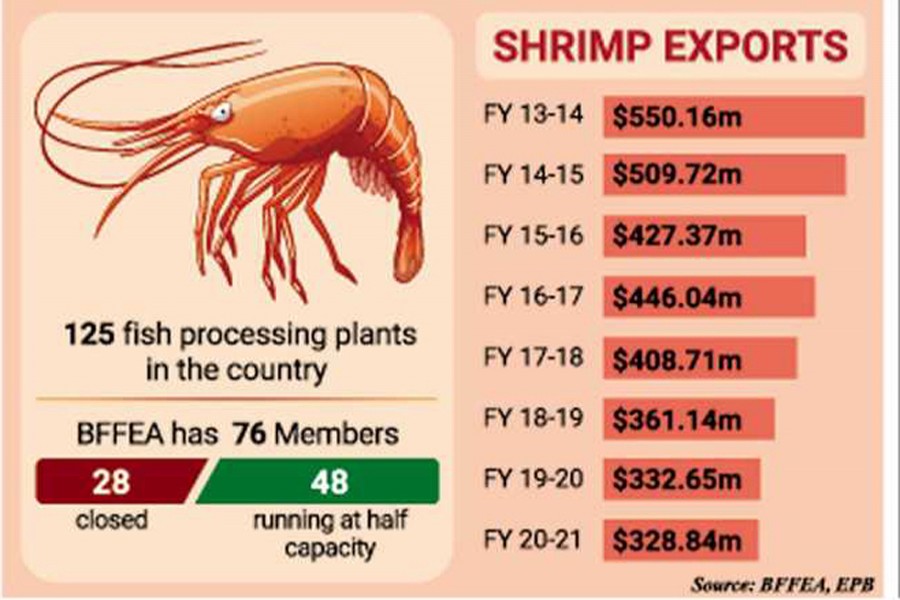The country's shrimp exports continued to fall for the last seven fiscal years since FY2013-14 mainly due to decline in the demand for the comparatively high-priced local varieties in the global market, industry insiders said.
They said the prices of local varieties - 'black tiger' and 'galda' - are higher than that of the major competitor 'Vannamei', which the restaurants prefer to serve on the tables due to its cheaper rates.
The earnings from shrimp exports fell to US$328.84 million in FY 2020-21 from $550.16 million in FY 2013-14, according to Export Promotion Bureau (EPB) data.
The insiders said the shrimp farming in the country was gradually reducing and processing plants were getting sick for lack of export orders.
Lower yields push up the prices of local varieties and the high prices discourage the importers, they said while talking to the FE, adding that shortages of shrimp fry and cultivable area have only deepened the setback. They also expressed disappointment that they have long been trying to get clearance for farming the high-yielding variety of Vannamei so that they can compete and sustain the global competition, but failed so far.
"That's what the consequence one can see reflected in the export data," said an exporter.
Talking to the FE, an exporter said the buyers were cutting costs due to the global economic slowdown followed by the COVID-19 fallouts, resulting in the declining demand for the Bangladeshi shrimp.
A pound of local shrimp now costs from US$ 6.0 to $ 6.50 while the price of Vannamei is almost half ($3.0-$3.50 per pound), he said.
Bangladesh follows the traditional way of farming and gets only 250-350 kg of shrimp per hectre - lowest output in the world. Even the global production of these black tiger and galda varieties also have not been increasing due to increased production cost, industry people said.
Consequently, they informed that dozens of shrimp processing plants in the country faced closure during the last five to seven years while most of the operational processing facilities were running much below their capacities.
According to Bangladesh Frozen Foods Exporters Association (BFFEA), there were a total of 125 fish processing plants across the country.
The association has a total of 76 members and some 28 were closed during the last few years while only 48 plants are running but cannot utilise more than half of their capacities.
They said the demand for the expensive product, often termed as 'white gold', has recently been increasing in the international market as the global economy has started recovering from the pandemic.
They believe that they could have slowed down the export slump had the authorities allowed farming the Vannamei variety.
"Unfortunately, we are yet to get approval for commercial farming of Vannamei in the country despite lobbying with concerned government agencies since 2005," BFFEA president Mohammad Aminullah told the FE on Saturday.
The exporters said the government is scared of 'unknown and unseen' diseases, and apprehensive of spreading the diseases that might damage the local fish varieties including that of the shrimps.
Meanwhile, Mr Aminullah said, after many years of persuasion, the government in 2018 allowed the exporters to go for Vannamei farming on a test basis. Though completed two such projects successfully, the government is yet to allow its commercial farming.
Referring to the Department of Fisheries, he informed the FE that on an average 9,000 kg of vannamei per hectre was harvested from the two projects which is considered to be 'very 'successful'.
The Department of Fisheries has been asking for piloting more projects in this regard, and that the pilot projects should be carried out by the government research agencies concerned, they said.
They also informed that despite limitations and high investment, the two pilot projects were implemented by the private sector.
The Ministry of Commerce on December 09 last held an inter-ministerial meeting, reviewing the issue of shrimp export performance.
The meeting discussed a number of reasons that allegedly have hindered farming shrimp through modern semi-intensive ways which need huge amounts of investment.
The MoC would recommend the fisheries ministry to take necessary measures to help increase the shrimp exports, meeting sources said.
When contacted, ministry sources said the government will hold another meeting with all stakeholders shortly to look into the issue.
According to the Global Aquaculture and Alliance and FAO, world Vannamei cultivation reached 3.55 million tonnes in 2018 from 2.7 million tonnes in 2013.
The variety has now grabbed about 77 per cent of global export markets while prawn holds only 11 per cent.
The competitor countries including China, India and Vietnam have increased their production by introducing Vannamei cultivation and grabbed the larger share of the international market.
Vannamei production in China increased to 1.14 million tonnes in 2019 from 0.98 million tonnes in 2016 while in India it rose to 0.72 million tonnes from 0.49 million tonnes and in Vietnam it rose to 0.56 million tonnes from 0.32 million tonnes, the BFFEA president said.


